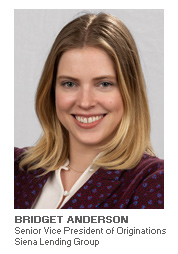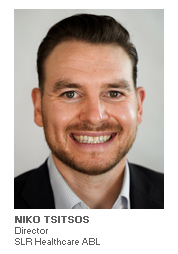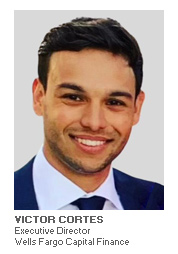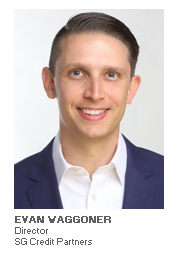
In this new ABL Advisor feature, Charlie Perer sits with four commercial finance next generation of Business Development Officers (BDOs) to discuss the role of BDOs in today’s market, generational changes and new strategies. The purpose of this series is to hear their views and how they are positioning their businesses for success.
Here to tell the story are Bridget Anderson, Senior Vice President of Originations at Siena Lending, Victor Cortes, Executive Director at Wells Fargo Capital Finance, Niko Tsitsos, Director at SLR Healthcare ABL, and Evan Waggoner, Director at SG Credit Partners.
Charlie Perer: Please briefly introduce yourselves.

Bridget Anderson: I am responsible for Midwest originations at Siena Lending Group. I joined the Siena team in August of 2022. Siena is a non-bank asset-based lender focused on middle-market transactions ranging from $10 to $100 million. Prior to my time at Siena, I spent 7 years with PNC Bank where I spent 3 years at the Corporate Bank as an underwriter and 4 years at PNC Business Credit as an originations associate and a relationship manager.
Victor Cortes:I’m currently a business development officer with Wells Fargo Capital Finance (WFCF) covering the greater Los Angeles market, the central California region, Nevada, Idaho and Hawaii. I have spent my entire career in asset-based lending between WFCF and PNC Business Credit. I started at WFCF in field exam, and after two years I transitioned into their Financial Analyst Program. Quickly thereafter, I became an underwriter for corporate and middle-market ABL deals. From there, I took a relationship manager position at PNCBC focusing primarily on sponsor backed deals, before taking on a BDO role within the PNCBC originations team. After some time in that role, I learned that Wells Fargo was expanding their west coast ABL business development strategy and decided to pursue an opportunity on that growing team.

Niko Tsitsos: I am responsible for originating new asset-based revolving lines of credit for healthcare providers and other healthcare companies on the west coast for SLR Healthcare ABL. We specialize in lending on third-party reimbursable accounts receivable (i.e., medical receivables due from Medicare, Medicaid, commercial insurance, etc.).
Evan Waggoner: I currently lead business development for the Consumer Products division of SG Credit Partners. I started my career as an analyst at WFCF and spent time in both underwriting and originations. My early years involved more generalist coverage in WFCF’s Business Finance group, whereas my more recent years have pushed me more toward Consumer Products, where I have a real passion for working with emerging brands.
Perer: Describe today’s lending landscape through the scope of your business and functional role, and how that affects your approach as a BDO?

Cortes:We are in an interesting and competitive lending environment, especially for ABL. Not only are there more private credit funds and non-bank ABL shops in the market today looking to deploy capital, but commercial bank lenders are trying to hold onto and win deals more aggressively than before. I have noticed that commercial bankers have been stretching above their traditional comfort levels by not focusing so much on cash flows, but rather, diving deeper into the collateral to either retain a customer or onboard a new relationship, while offering the same pricing. Should a Company need more than what the commercial bankers are able to provide, the only plausible take out is a non-bank ABL solution. Not to say every opportunity is like this, I have just encountered this trend more frequently than before. This year, I have noticed that cash flow commercial banks are tightening their credits and suspect we will see more cash-flow to ABL conversions in the second half of the year.

Waggoner: Our business tends to focus on companies that often don’t qualify for bank financing. In many ways, this limits options for companies that are seeking credit, but it also creates opportunities for lenders to distinguish themselves among the competition. We are in the midst of a dynamic and fast-evolving market, where more lenders than ever are competing for a shrinking “top tier” of deals, and my approach is centered around finding ways to bring real value to our borrowers.
Anderson: The lending landscape is very competitive right now. With the slowdown in M&A, competition among lenders for new deals is fierce (from both traditional banks and non-bank lenders). I try to emphasize what sets Siena apart, which is speed to execution and certainty to close. Siena is a flat organization, which means that the same team that gives their blessing on my initial terms is the team that provides final credit approval. When roadblocks come up in diligence, our underwriters are good at finding creative solutions (and getting buy in from credit committee) to keep the process moving towards a successful closing. In addition, we have a team that has a long history of working together, dating back to their time before Siena. Their understanding of each other’s communication and credit decisions along with the trust that they each have boosts our origination team’s confidence in pursuing new deals.
Tsitsos: Today’s lending landscape is hypercompetitive. Non-bank lenders are more determined to grow, deploy more capital, and acquire assets than ever as the private credit market continues its expansion. Meanwhile, although most national banks have tightened credit standards, regional banks remain protective of their existing credit relationships as a means to retain deposits. We’ve had to adapt and find new ways to offer a more compelling solution in order to stand out in competitive situations, whether it be greater flexibility on covenants, shorter term commitments, softer guarantees, etc. With that said, even in this competitive market, I find that companies and management teams are still highly interested in finding lending partners that provide accurate and timely feedback, flexibility, full transparency and trust.
Perer: Do you see any stylistic differences between your generation of BDO versus older generations nearing retirement?
Tsitsos: There are some stylistic differences in how we approach networking, but the basics—the blocking and tackling—are the same. It’s impressive how connected the older generation is. That doesn’t happen overnight and takes years of dedication to growing their networks, doing all the little things my generation of BDOs are focused on daily. Stylistically, while it’s still important to cast a wide net, I think today’s market requires you to be more strategic and targeted in your approach, then take the time to develop the relationships that you think will be most meaningful.
Anderson: There are probably a lot of things that have not changed about being a BDO 25 years ago versus now. Those of us at the beginning of our sales career still have to put in the time of countless coffee meetings, lunches and events. But there is objectively a lot more diversity among professionals in asset-based lending today. I think that is a good thing. I love connecting with people on what they are passionate about outside of work. Personally, I have many hobbies and find that it allows me to find commonality with people from all walks of life and backgrounds. This has allowed me to establish my own personal brand and build deeper connections with referral sources.
Waggoner: I believe that my generation uses auxiliary marketing channels (i.e. social media) more frequently than generations past, and overall, we’re able to gain more insight on where to spend time and energy from the numerous informational resources (i.e. SPINS/Neilsen, CapIQ, Pitchbook, etc.) that are now available to everyone in the market.
Cortes: The main difference I’ve noticed is formality, which I think comes more from a societal shift more than anything else. I think my generation of BDOs are less formal in interactions and overall approach compared to the prior generation.
Perer: What’s your go to market strategy that is unique from others?
Anderson: I believe my experience managing a portfolio of asset-based lending borrowers sets me apart from other originators. While those in sales and underwriting roles are focused on getting a borrower through diligence to a successful close, I am focused on setting up clients for long term success. As a portfolio manager, I experienced and worked with businesses through various seasons and cycles. In my role today, I am always contemplating how to structure deals not only for the present moment but also with an eye towards the future and how we can collectively navigate it.
Waggoner: Relationships are my top priority when going to market. While I’d love to be able to know every potential partner of ours, my aim is quality over quantity, which really allows me to focus on the needs of our customers. BDOs represent and speak for their firms, so I try to be as open and honest as possible with everyone that I interact with. Sometimes conversations are difficult and awkward but facing them head on will always result in stronger relationships.
Tsitsos: Being specialized in healthcare makes my go-to-market strategy inherently unique from other ABL lenders. The majority of my deal referrals come from banks and other ABL lenders that do not provide credit to healthcare providers and/or lend on medical receivables. I market myself as more of a partner and resource for my referral source network.
Cortes: I don’t think my approach is overly unique, as I think others may do this as well, but I tend to probably ask for too much information and do a deep dive up front when assessing any opportunity. Given my field exam, underwriting and portfolio experience, I want to make sure I fully understand the collateral, trends, the company’s needs from a new lender relationship, the management story behind the performance, and make sure that the story being told by management aligns with the story being told by the numbers. I like to think that the BDO should know the deal better than anyone else to be effective in building the initial relationship with the company. By scrubbing the information at this level, it allows me to be an advocate for the company and garner support for the transaction, as I should be able to address any questions given my familiarity with the company. The key with this though, is how to quickly get up not speed with so much information, while not giving the company a false hope, which makes transparency so important. Overall, my general strategy is to quickly conduct a mini-underwrite in order to provide timely and candid feedback to the Company. Not all feedback will be positive but being able to provide a quick “no,” and what it would take for a “yes” or even a “maybe,” goes a long way in building a trusting relationship (with the company or referral source).
Perer: What marketing tools (i.e., social media, trade shows, cold calling, etc.) do you find the most useful?
Waggoner: I think that LinkedIn is a great marketing tool for general communications which can be really helpful as a primary or secondary coverage strategy. Generally, social media is a tricky channel to market yourself or your product, and I don’t think that many lenders in our space have successfully utilized any other platforms beyond LinkedIn. Rather than spending a lot of time cold calling. I love going to conferences and trade shows where I can meet brands, sample products and get to know the founders.
Cortes: I haven’t been one to use social media as a marketing tool as much as I would like. I am sure there are benefits that come from it, but it seems as if there is so much noise on social media (personal posts, inspirational posts, self-promotional posts, advertising posts) that any marketing posts tend to get lost in the mix, diluting the impact it carries. I tend to focus on trade shows along with networking events, where I can have a more meaningful and direct dialogue with individuals. Being able to connect in-person allows for a connection that social media and cold calling lacks. Each person is different, so what works for me may not be the best for someone else. The most useful tool is figuring out which method allows the person to be most themselves, which I believe will lead to a natural connection. I view each marketing tool as a way to get your foot in the door, but it’s what you make of the opportunity once you are in the room that will determine how useful it really is.
Anderson: In my opinion, you can’t beat the simple coffee meeting. I do believe meeting in person is beneficial. Especially at the beginning of a relationship, facetime is very helpful in building rapport and more of a personal relationship. By having coffee meetings, I’m not taking too much of someone’s workday but it’s a good venue to catch up on both work and life.
Tsitsos: I’ve found in-person conferences to be the best way to expand my reach and make meaningful connections. The people that attend conferences are the people most willing to meet. Everyone is busy and we all get inundated with emails, so there needs to be a purpose behind your outreach efforts and a call to action. Conferences are the best opportunity to gain someone’s attention.
Perer: What has it been like beginning or growing your career in a remote environment?
Tsitsos: I wouldn’t trade the beginning of my career in an office environment for anything. Not just for the connections I made but being up close and personal with the people who worked in the jobs that I wanted. Observing how they went about their day to day, how they interacted with internal team members and external clients, their work ethic, etc. was my real training. In today’s remote environment, your in-person time is more valuable.
Cortes: To a certain extent, I really enjoyed growing my career in a remote environment, as it allowed for a higher level of productivity and removed the sense of office competitiveness that sometimes distracts from the core work. On the other hand, remote environment didn’t allow for quick and easy interactions that help build a working relationship. I don’t think a fully remote environment promotes camaraderie nor helps anyone grow their careers, as nothing replaces in-person interactions and face-to-face meetings.
Anderson: I am glad that the remote work environment has made video calling more popular. I enjoy getting to see the rest of the Siena team on a zoom call for pipeline meetings every week even though many of us sit in different geographies. I also find it is easier to build rapport with prospects over video call. A lot of communication is non-verbal, and those things get lost over the phone.
Waggoner: Pre-COVID, my team was typically in the office all five days of the week, so the transition to what is now a fully remote role has been challenging but is ultimately enjoyable. I sincerely miss the daily interactions and the ease of getting to know my co-workers on a deeper level. On the other side of the coin, this new way of working offers significantly more flexibility to my personal life, which is incredibly valuable to anyone in business development.
Continued on Page 2...